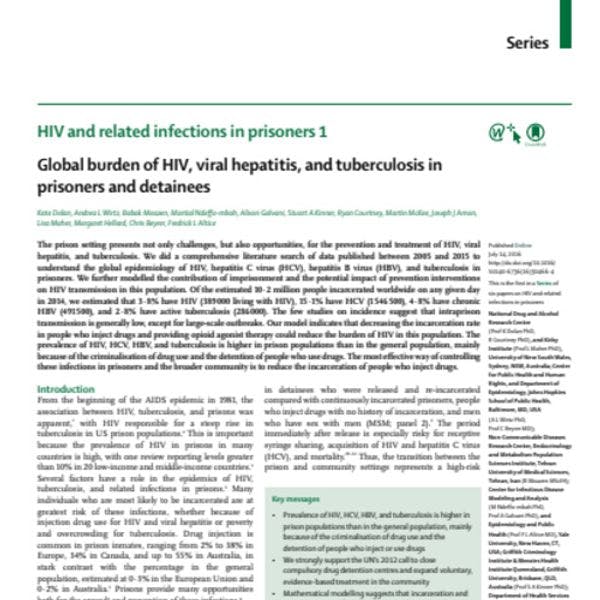Global burden of HIV, viral hepatitis, and tuberculosis in prisoners and detainees
The prison setting presents not only challenges, but also opportunities, for the prevention and treatment of HIV, viral hepatitis, and tuberculosis. We did a comprehensive literature search of data published between 2005 and 2015 to understand the global epidemiology of HIV, hepatitis C virus (HCV), hepatitis B virus (HBV), and tuberculosis in prisoners. We further modelled the contribution of imprisonment and the potential impact of prevention interventions on HIV transmission in this population. Of the estimated 10·2 million people incarcerated worldwide on any given day in 2014, we estimated that 3·8% have HIV (389 000 living with HIV), 15·1% have HCV (1 546 500), 4·8% have chronic HBV (491 500), and 2·8% have active tuberculosis (286 000). The few studies on incidence suggest that intraprison transmission is generally low, except for large-scale outbreaks. Our model indicates that decreasing the incarceration rate in people who inject drugs and providing opioid agonist therapy could reduce the burden of HIV in this population. The prevalence of HIV, HCV, HBV, and tuberculosis is higher in prison populations than in the general population, mainly because of the criminalisation of drug use and the detention of people who use drugs. The most eff ective way of controlling these infections in prisoners and the broader community is to reduce the incarceration of people who inject drugs.
From the beginning of the AIDS epidemic in 1981, the association between HIV, tuberculosis, and prisons was apparent, with HIV responsible for a steep rise in tuberculosis in US prison populations. This is important because the prevalence of HIV in prisons in many countries is high, with one review reporting levels greater than 10% in 20 low-income and middle-income countries. Several factors have a role in the epidemics of HIV, tuberculosis, and related infections in prisons. Many individuals who are most likely to be incarcerated are at greatest risk of these infections, whether because of injection drug use for HIV and viral hepatitis or poverty and overcrowding for tuberculosis Drug injection is common in prison inmates, ranging from 2% to 38% in Europe, 34% in Canada, and up to 55% in Australia, in stark contrast with the percentage in the general population, estimated at 0·3% in the European Union and 0·2% in Australia.5 Prisons provide many opportunities both for the spread4 and prevention of these infections.
Keep up-to-date with drug policy developments by subscribing to the IDPC Monthly Alert.
Downloads
Regions
Related Profiles
- The Lancet
